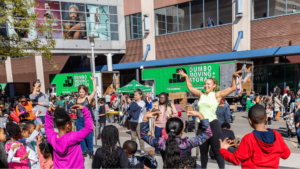Finding volunteers for your next event is definitely possible.
And you probably know that recruiting the right volunteers can be the make or break of your event. Having access to eager and caring volunteers can get you over the finish line and help you build an ironclad community around your event.
But, finding the right people to help you pull off your next fundraiser or charity event can be challenging. That’s why we’ve created this guide.
Read on to find out how to create a volunteer program, recruit volunteers for your event, prep your volunteers, and avoid epic volunteer fails.
Table of contents
How do you create an event volunteer program?
How to recruit event volunteers
Creative ways to recruit volunteers
How to attract and retain event volunteers
How to get your volunteers ready
How to avoid event volunteer fails

How do you create an event volunteer program?
Your volunteer recruitment strategies should begin as soon as you know how many volunteer positions need filling. You’ll need to know how much staff your event will require and whether you’ll need volunteers to supplement your team.
When planning an event, think about the areas for which volunteers would be a great help.
A smooth-running event will typically require volunteer positions such as:
- Setup: Chairs, tables, sound systems, video controls, banners, decorations, and kiosks all need moving in and arranging.
- Door entry and ticket selling/registration: Position this person at the main entrance.
- Ushers: They escort people to their seats and are typically used in more formal events.
- Swag handler: If you’re giving out sponsor-donated swag or other gifts, you need to assign this task to someone.
- Merch seller: If you’re selling t-shirts, coffee mugs, or other branded merchandise, you’ll need a cashier.
- Cleanup: Once the party’s over, it’s time to tidy up and sort out; help is always appreciated.
Want to see how to manage a team of potential volunteers?
Check out event creator Runway for a Cure, who raises funds for an amazing cause — helping people with cancer. To ensure everybody stays on-brief and knows how to help, they split their volunteers between a light staging and decor team, a backstage setup team, and a guest services team for administrative tasks.
💡Pro tip: To create an effective volunteer program, clearly define your event volunteer requirements. So, what skills and attributes should your ideal volunteers have?
For instance, if lifting heavy items or climbing stairs is part of the job, ensure you’re upfront about the physical requirements.
Or, if you expect many event attendees who speak Spanish, Chinese, or another language, you may want bilingual volunteers. Also, consider using volunteers over 18 or 21 for legal reasons or if alcohol is being served (check local regulations).
Being clear about your requirements, time commitments, and recruitment tasks will help you find good matches.

How to recruit event volunteers
Once you’re clear on your volunteers’ requirements, it’s time to learn how to recruit volunteers so you can find the right people to represent your event brand. Include as many avenues of pursuit as possible to increase your pool of potential volunteers.
Email past event attendees or subscribers
Current supporters who are on your mailing list or who have registered in the past are already excited about your event and/or cause.
Get in touch to gauge their interest in volunteering.
Want to streamline the process? Take advantage of Eventbrite’s integration with Mailchimp. It enables you to pull contact details from past Eventbrite registrations directly through to your Mailchimp account so you can send slick email campaigns in just a few clicks.
Automate your event emails.

Reach out to community groups
If there’s a community group involved in the event already, reach out to ask for volunteers. You can also contact local colleges, community halls, libraries, businesses, and supermarkets to share volunteering opportunities.
💡Pro tip: Don’t stop with in-person flyers because the quickest way to reach community groups is to get social. Reach out to communities through closed Facebook groups, industry accounts on Instagram and X (formerly Twitter), or LinkedIn groups.
Advertise opportunities on volunteering networks
People love to get involved with a good cause. That’s why many potential volunteers turn to volunteer matching sites, and you should, too.
These volunteering marketplaces match qualified volunteers with nonprofit organizations and event creators with volunteer opportunities to fill. They’re a fast, simple, and affordable (sometimes free) way to reach your target audience.
If you’re new to volunteer matching sites, here are a few of our favorites:
Some websites are industry-specific — so be sure to have a look to find the perfect volunteer matching site for you and your event.

Creative ways to recruit volunteers
Drive interest and get new volunteers in the door by making the position sound advantageous.
One way to reach out to your target audience is to use social media influencers. By collaborating with big names in your industry, you can leverage their popularity to lift your own brand.
Another creative option is to host a volunteer open house, volunteer info session, or even a volunteer luncheon. By inviting potential volunteers to visit your venue for a chat, you can answer their questions and motivate them to join you.
Event creator Lemon Tree Collective is great at this. The autism charity’s recent Volunteer Open House included complimentary refreshments, free beer and wine, and even a $100 prize giveaway — all while educating guests about the benefits and joys of becoming a volunteer.
You could also offer referral prizes for new volunteers, such as a free t-shirt for volunteers who bring a friend.

How to attract and retain event volunteers
If you want people to volunteer their time, you should offer them an incentive. It might be that they earn a special level of event access once their shift ends, a discount on merchandise, or tickets for a cool giveaway.
For some inspiration, take a look at Tales of the Cocktail.
To motivate volunteers and give them something to look forward to, they’ve implemented a reward system: Volunteers who work two shifts at the cocktail event earn a free admission ticket. Volunteers who work four shifts get a second free ticket, and everybody gets the option to attend a few of their other events.
Another great way to boost volunteer retention is to show how much you appreciate their efforts. For example, name a dedicated volunteer of the month on your social media platforms, post pictures of them hard at work, and show how grateful you are by thanking them publicly.
💡Pro tip: People love to learn new skills. You can easily attract volunteers by offering expert workshops from some of your support staff, guided training sessions, or even mico-credentials (if you’ve got the time and budget).
How to get your volunteers ready
The first step to successful event volunteer management is to train volunteers for an event so they understand their duties come showtime.
Festival volunteer management for chat rooms and other online communications might be needed for virtual or hybrid events, including a working familiarity with Zoom, Vimeo, and other streaming platforms.

Create a volunteer orientation program
Before you start recruiting potential volunteers, you should already have an orientation program lined up to make the recruitment process as quick as possible.
Whether it’s in-person or online, review what volunteers should expect on event day and any requirements of them beforehand, such as attending rehearsals. Share details about what to wear, what to bring, where to meet, and what time to report on the day of the event.
💡Pro tip: Give prospective volunteers a single contact person to reach out to if they have any questions about their training.
You might even want to appoint a current volunteer to run your orientation program. They’ll be able to provide your new volunteers with a warm welcome, clarify details about the job description, and give new volunteers a chance to hear positive experiences about the program first-hand.
Train your volunteers
Make sure you build in some extra time to train volunteers so that there’s no confusion or last-minute stress on the day of the event. The last thing you want to do is make your volunteers feel like they’re flying solo.
There are different training options depending on how many volunteers you’re working with and what they’ll need to learn. You might want to set up a virtual training session or send them some guidance documents and a few short videos to get them up to speed — but it could also be worth inviting your volunteers to an in-person training session before the event.
💡Pro tip: If you’re already using event management software like Eventbrite, get your volunteer coordinator to create a separate volunteer training session and email the invite to all your potential volunteers.
You can even use Eventbrite’s integration with Zoom to set up a hybrid training session to build volunteer engagement for those unable to make it in person.

How to avoid event volunteer fails
Coordinating a team of volunteers can be challenging, even if you follow the steps above. Your volunteer management strategies need to include how to resolve any hiccups along the way and on the day.
Don’t get into legal trouble
Creating a robust volunteer program isn’t just about defining volunteer roles and attracting future volunteers. You also need to make sure you’re ticking all the right legal boxes.
The U.S. Department of Labor actually has specific rules that distinguish between volunteers and employees to make sure you’re not taking advantage of anyone. Be sure to check those out.
For example, under the U.S. Government’s Fair Standard Labor Act, public workers aren’t allowed to volunteer unpaid overtime to perform the same types of activities they do at their day job. Likewise, employees of other companies aren’t allowed to volunteer their services to other for-profit private sector companies.
Create a code of conduct
Spell out your expectations to eliminate confusion.
Some key points can include dressing appropriately, being respectful to other volunteers and attendees, and how to report potential problems or safety hazards.
For some lessons in best practice, take a look at event creator Holland/Zeeland Young Professionals. To prep active volunteers for their upcoming event, they encouraged registrants to review safety guidelines, spelling out what’s expected of individual volunteers while they’re on the job.
This ensures all potential volunteers know exactly what they’re getting into when they arrive.
Over-recruit
It’s highly possible that some volunteers won’t show up after all.
People lead busy lives, and some volunteers tend to drop out when life happens. It’s always better to have a few extra volunteers than not enough, so sign up more to account for no-shows.
Ready to start recruiting volunteers?
Recruiting a team of active volunteers can alleviate time constraints and simplify the event planning process. — not to mention that it’s a way to build on resources and skills that others have.
You’ve just got to get creative when it comes to attracting and training up your volunteers — and we’re here to help.
With Eventbrite, you can easily recruit prospective volunteers, stay in touch with them, and even set up virtual opportunities for training sessions online.






